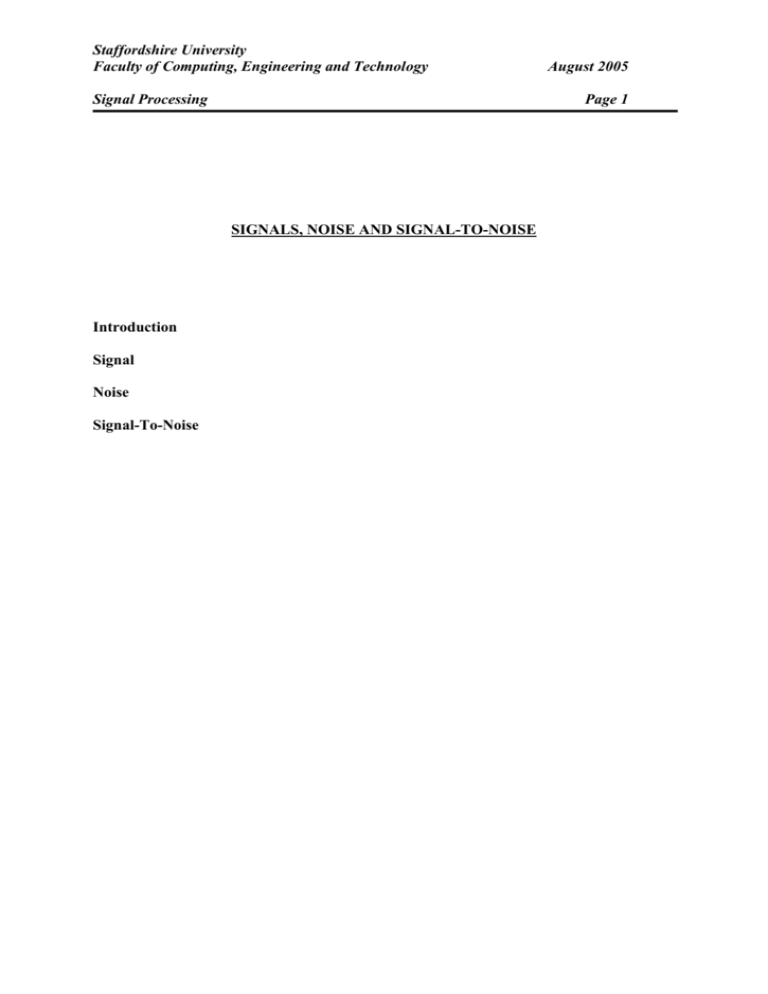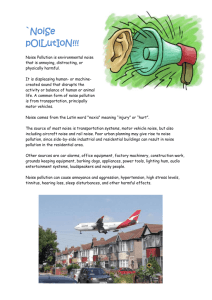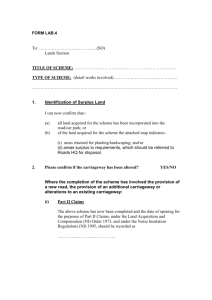SIGNALS, NOISE AND SIGNAL-TO-NOISE
advertisement

Staffordshire University Faculty of Computing, Engineering and Technology Signal Processing Page 1 SIGNALS, NOISE AND SIGNAL-TO-NOISE Introduction Signal Noise Signal-To-Noise August 2005 Staffordshire University Faculty of Computing, Engineering and Technology August 2005 Signal Processing Page 2 SIGNALS, NOISE AND SIGNAL-TO-NOISE Introduction A signal (in our case a radio or electronic signal) is something which contains information. The purpose of the communication system is to transfer the information. The quality of the received information is affected by noise. Noise is a term that includes: Naturally occurring noise and interference, eg background ‘sky’ noise from the universe, atmospheric noise, lightening etc. Circuit noise due to the movement of electrons in semiconductors and resistors etc. Man made noise and interference, eg car ignition, triac control circuits, crosstalk between circuits, mains ‘hum’ etc. EMC regulations and proper design and control attempts to minimize ‘man-made’ noise and interference. Noise affects the quality of the received signal. For example noise in digital data will cause the 1’s and 0’s to misread and errors occur. The probability of errors depends on the signal-tomove ratio. Analogue signals, such as speech or music are affected by noise in the form of ‘hiss’ or crackle which affects the quality of the signal. Signal The two main parameters of a signal relevant to this section are its power S, and its spectral bandwidth. The average power (or normalized average power) of a signal is denoted by S. The signal comprises a band of frequencies and amplitudes, varying from instant to instant in a random way. The signal spectrum is usually bandlimited, i.e. it is limited to a bandwidth say BHz, as illustrated below. Staffordshire University Faculty of Computing, Engineering and Technology August 2005 Signal Processing Page 3 Signal f Signal Power S Bandlimited Signal f B Noise Noise is often assumed to be Additive, White, Gaussian noise (AWGN). Additive - means we assume we can add noise powers and signal powers. N1 N2 S + N1 + N2 S White - refers to the spectral density and assumes that the noise appears equally is all parts of the spectrum (the term is from ‘white’ light which is composed of all colours in the spectrum). White noise assumes a uniform noise power spectral density of p0 watts per Hz. Noise Power Spectral Density p0 watts per Hz Uniform for all practical frequencies f Gaussian – is saying that it is random, with a particular (Gaussian) probability distribution. Staffordshire University Faculty of Computing, Engineering and Technology August 2005 Signal Processing Page 4 The average or normalized average power of noise is denoted by N. It is found that the power in a noisy signal is proportional to the bandwidth in which it is measured as implied by the relationship. N = p0Bn Bn is the noise bandwidth in Hz. p0 is the noise power spectral density in watts per Hz. p0 is related to the assumption of white noise as shown in the diagram above. This means that if we allow more bandwidth in the communication system, we will get more noise. For example, suppose the noise power spectral density p0, is 1W per Hz. The noise power for various bandwidths are shown below. p0 1W 1W 1W Bn 10Hz 1kHz 10kHz N 10W 1000W = 1mW 10mW In communications systems therefore – there is a balance to be found in terms of the bandwidth allocated : 1) That it is wide enough to pass the signal with power S and spectral bandwidth B Hz. 2) That is kept narrow (i.e. no wider that that required for the signal) to limit the noise. One of the purposes of a filter in a system is to bandlimit noise as illustrated below. Staffordshire University Faculty of Computing, Engineering and Technology Signal Processing Signal and Noise Input August 2005 Page 5 Signal Poor Signal-to Noise Noise f Band Pass Filter B Signal and Noise Output Signal f Improved Signal-to-Noise Noise f In terms of waveforms, this is equivalent to: Signal and Noise Input Signal and Noise Output Staffordshire University Faculty of Computing, Engineering and Technology August 2005 Signal Processing Page 6 Signal-To-Noise The parameter, which gives an indication of the quality of the output, is the signal-to-noise S . N Expressed as a ratio this is simply: Power S N Signal Noise Power Expressed in decibels, this is: S N dB 10 log S N This may be further developed as: S N dB 10 log 10 10 S 10 log 10 N If S and N are in mW, then: SdBm = 10 log10 S(mW) and NdBm = 10log10 N(mW) and S N dB = SdBm - NdBm Some typical values of signal-to-noise are given below: Good television picture High Quality Audio Broadcast Music Cellular Mobile Radio ET ACS 45dB 80dB 60dB 17dB minimum







